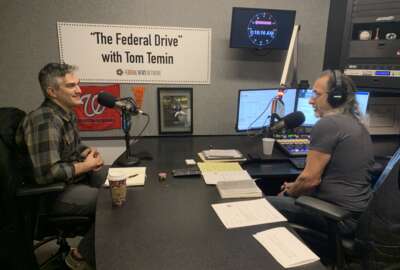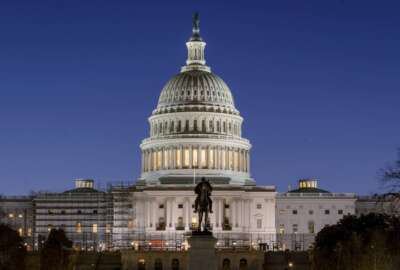
Deputy US CTO Lynne Parker, top federal AI expert, leaving government
A top artificial intelligence expert in the Obama, Trump and Biden administrations is leaving government.
Best listening experience is on Chrome, Firefox or Safari. Subscribe to Federal Drive’s daily audio interviews on Apple Podcasts or PodcastOne.
A top artificial intelligence expert in the Obama, Trump and Biden administrations is leaving government.
Lynne Parker, the deputy U.S. chief technology officer and director of the White House’s National AI Initiative Office, is returning to academia after seven years of federal service.
Parker helped stand up the National AI Initiative Office last year, meant to help put federal AI research and development resources in the hands of more industry and academic partners. She’s also led efforts to develop the first federal R&D strategic plan, as well as subsequent updates.
The federal government has taken major strides in becoming AI-ready since 2016, when Parker, under the Obama administration, co-led efforts to release the first federal AI Research and Development Strategic Plan.
Parker also helped update the federal R&D strategy in 2019, which she said, “kicked off a lot of federal and national activity in AI that has continued today.”
AI.gov currently lists more than 20 AI strategy documents and strategies from agencies, as well as several governmentwide policy documents diving into specific AI topics, such as developing a STEM workforce and setting AI technical standards.
“Agencies are acting on these reports, and they’re implementing the ideas. The bottom line is that the agencies have built up their capacity and prioritization of AI, and its use in their agencies. They’ve put a lot of thought into how they can best use the technology to advance their missions, and think about how they use AI responsibly to make sure that no harms are going to result from their use,” Parker said.
A third update to the national AI strategy will be released at the end of this calendar year. The strategies, to date, have focused on the following priority areas:
- Long-term investments in AI research
- Human-AI collaboration
- Ethical AI
- Ensuring the safety and security of AI
- Shared public data sets and environments for AI training and testing
- AI standards and benchmarks
- Better understanding the national AI R&D workforce
“We’ve made good progress in all of those areas, But there continues to be a number of open areas that will be fruitful for future work as well,” Parker said.
The task force behind the National AI Research Resource (NAIRR), co-led by Parker and the National Science Foundation, issued an interim report in May, outlining how the AI data-and-research hub can put federal AI resources in the hands of more U.S. researchers. A final report is expected this November.
Parker said the value of the NAIRR stems from “democratizing access to these resources” including the data, test beds and high-performance computing capabilities necessary to further AI research.
“The challenge these days is that the pathways into AI research are too often accessible only by a limited few researchers — these researchers who have access to large-scale computational and data resources,” Parker said. “Typically that’s large technology companies, or well-resources universities or national labs. For the United States to sustain its leadership in AI R& D, it’s essential that we enable the full and diverse talent of the nation to contribute to this AI innovation ecosystem.”
Building the next generation of federal AI talent
Meanwhile, the Biden administration is looking at new ways to bring AI experts into government.
“At the end of the day, the key determinant to global competitiveness comes back to our people. We need to have talented skilled people who dig into these fields and contribute with new ideas and innovations. The competitiveness angle is very much tied to our education and workforce training needs,” Parker said.
The Office of Personnel Management, Parker said, is taking steps to establish an occupational series for AI work in government, and identifying rotational programs to bring AI expertise onboard at agencies.
“That will determine the current capacity and future needs of the federal government for AI talent,” Parker said.
The General Services Administration has also expanded its Presidential Innovation Fellows Program to establish an AI track, which is meant to attract experts from industry and academia to a period of work within the federal government.
“That program has also been very successful in bringing in tremendous experts into the agencies to help in many ways,” Parker said.
While the federal government is ramping up efforts to bring top AI talent into government, Parker said developing the next generation of AI talent with a diverse range of perspectives requires participation from industry and academia.
“It’s a tough challenge. It’s not a new challenge, and it’s been a continuing challenge for the last many years. And it’s something that needs a multi-pronged approach that helps build up our AI talent for the nation as a whole,” Parker said.
Beyond investments in AI basic R&D, Parker said the federal government has made major improvements to the U.S. AI research infrastructure.
NSF has partnered with the Agriculture Department’s National Institute of Food and Agriculture (NIFA), the Department of Homeland Security, Google, Amazon, Intel and Accenture to establish National AI Research Institutes across the country.
The institutes account for a total of $360 million in investments so far, and cover 40 states and the District of Columbia.
“These investments are, I think, very good at advancing competitiveness, because they bring together experts and students across many different disciplines, to advance AI and to solve tough challenges,” Parker said.
Copyright © 2025 Federal News Network. All rights reserved. This website is not intended for users located within the European Economic Area.
Jory Heckman is a reporter at Federal News Network covering U.S. Postal Service, IRS, big data and technology issues.
Follow @jheckmanWFED




